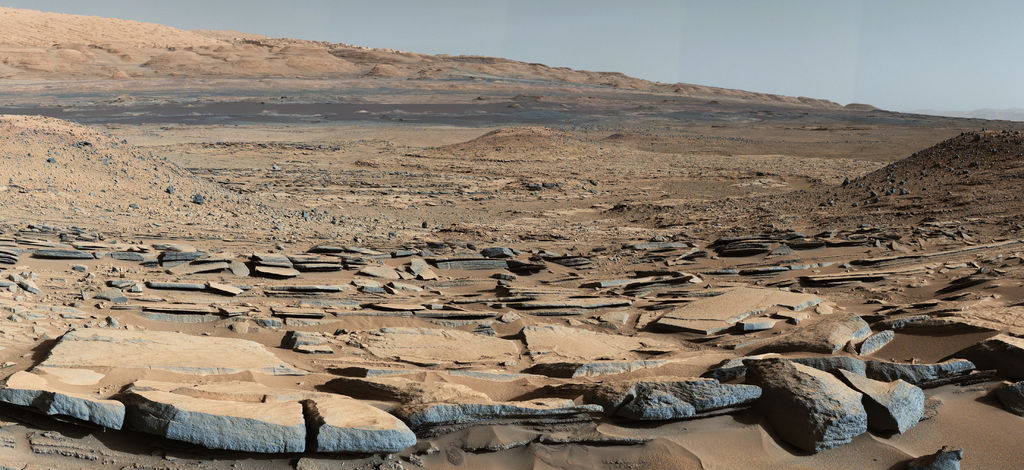
Last week there was the exciting news that Mars still has flows of briny water occurring now, and this week there is more water-related news: additional findings from the Curiosity rover that the huge Gale crater was once a lake or series of lakes a long time ago. Curiosity had already found evidence that there used to be shallow lakes and streams in this area, but the new data confirms this and suggests that the lake(s) once filled Gale crater and were long-lasting, explaining the formation of Mount Sharp in the middle of the crater and also providing a potentially habitable environment for life.
“Observations from the rover suggest that a series of long-lived streams and lakes existed at some point between about 3.8 to 3.3 billion years ago, delivering sediment that slowly built up the lower layers of Mount Sharp,” said Ashwin Vasavada, Mars Science Laboratory project scientist at NASA’s Jet Propulsion Laboratory in Pasadena, Calif., and co-author of the new Science article to be published Friday, Oct. 9, 2015.
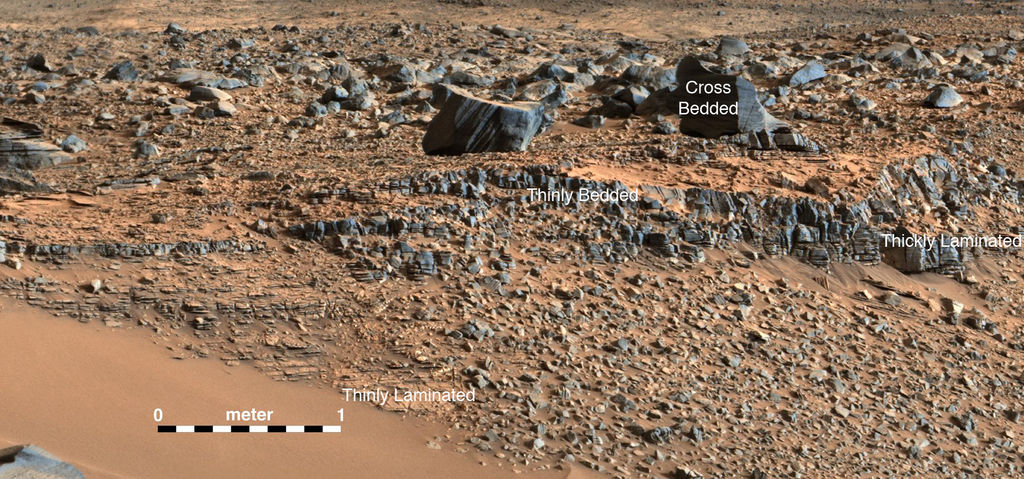
From the study of various rock outcrops examined by Curiosity, the mission team determined that water deposited large amounts of sediments into Gale crater, which helped to form the foundation of Mount Sharp.
“What we thought we knew about water on Mars is constantly being put to the test,” said Michael Meyer, lead scientist for NASA’s Mars Exploration Program at NASA Headquarters in Washington. “It’s clear that the Mars of billions of years ago more closely resembled Earth than it does today. Our challenge is to figure out how this more clement Mars was even possible, and what happened to that wetter Mars.”
From the abstract of the new paper:
“The landforms of northern Gale crater on Mars expose thick sequences of sedimentary rocks. Based on images obtained by the Curiosity rover, we interpret these outcrops as evidence for past fluvial, deltaic, and lacustrine environments. Degradation of the crater wall and rim probably supplied these sediments, which advanced inward from the wall, infilling both the crater and an internal lake basin to a thickness of at least 75 meters. This intracrater lake system probably existed intermittently for thousands to millions of years, implying a relatively wet climate that supplied moisture to the crater rim and transported sediment via streams into the lake basin. The deposits in Gale crater were then exhumed, probably by wind-driven erosion, creating Aeolis Mons (Mount Sharp).”
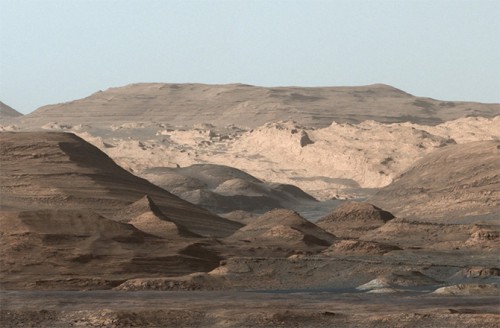
Analysis suggests that the bottom layers of the mountain formed over a period of about 500 million years, built up gradually by the lakes and rivers.
“During the traverse of Gale, we have noticed patterns in the geology where we saw evidence of ancient fast-moving streams with coarser gravel, as well as places where streams appear to have emptied out into bodies of standing water,” Vasavada said. “The prediction was that we should start seeing water-deposited, fine-grained rocks closer to Mount Sharp. Now that we’ve arrived, we’re seeing finely laminated mudstones in abundance that look like lake deposits.”
The lakes would have lasted for long periods of time, but may have expanded and contracted repeatedly over a period of hundreds of millions of years. The mudstones are one of the key pieces of evidence for standing bodies of water in Gale crater.
“These finely laminated mudstones are very similar to those we see on Earth,” said Woody Fischer, professor of geobiology at Caltech and coauthor of the paper. “The scale of lamination – which occurs both at millimeter and centimetre scale – represents the settling of plumes of fine sediment through a standing body of water. This is exactly what we see in rocks that represent ancient lakes on Earth.”
A large amount of sediment was deposited in Gale crater, which is now recorded in the many layers of the lower portions of Mount Sharp.
“Paradoxically, where there is a mountain today there was once a basin, and it was sometimes filled with water,” said John Grotzinger, the former project scientist for Mars Science Laboratory at the California Institute of Technology in Pasadena, and lead author of the new report. “We see evidence of about 250 feet (75 meters) of sedimentary fill, and based on mapping data from NASA’s Mars Reconnaissance Orbiter and images from Curiosity’s camera, it appears that the water-transported sedimentary deposition could have extended at least 500 to 650 feet (150 to 200 meters) above the crater floor.”
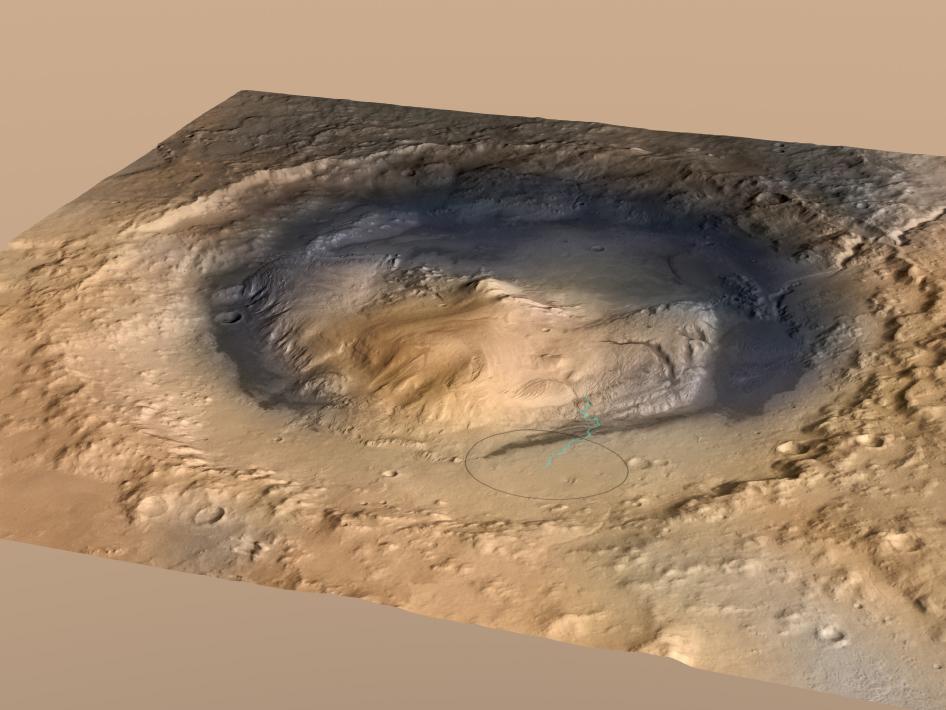
It is also noted, however, that the total thickness of the sedimentary deposits, which interacted with water, could extend up to perhaps one-half mile (800 meters) above the crater floor.
The upper portions of Mount Sharp, above 800 meters, show no evidence of water-deposited layers, so it is thought that they came later, with those strata deposited by wind.
The area where Curiosity is now, at the outer portion of the base of Mount Sharp, was once a lake bottom.
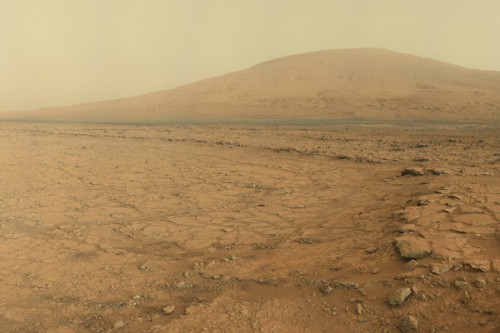
It is not yet known where the water came from, but at least some of it likely came from snowfall and rain. For water to remain stable on the surface, the atmosphere must have been thicker than it is now, as other evidence over the years has indicated. Whether it was a lot warmer or not is still a subject of intense debate, but just the fact that there used to be long-lasting lakes on Mars’ surface, perhaps even a northern ocean, shows that the climate was a lot more hospitable and Earth-like than it is now.
As mentioned by Grotzinger in Discovery News, “You have a deep hole, filled with water that is stable,” which indicates that Mars must have had a denser atmosphere at that point in its history than can be explained by current computer models.”
The paper concludes:
“Our observations suggest that individual lakes were stable on the ancient surface of Mars for 100 to 10,000 years, a minimum duration when each lake was stable both thermally (as liquid water) and in terms of mass balance (with inputs effectively matching evaporation and loss of water to colder regions). We estimate that the stratigraphy traversed thus far by Curiosity would have required 10,000 to 10,000,000 years to accumulate, and even longer if overlying strata are included. Though individual lakes may have come and gone, they were probably linked in time through a common groundwater table. Over the long-term, this water table must have risen at least tens of meters to enable accumulation of the delta and lake deposits observed by Curiosity in Gale crater.”
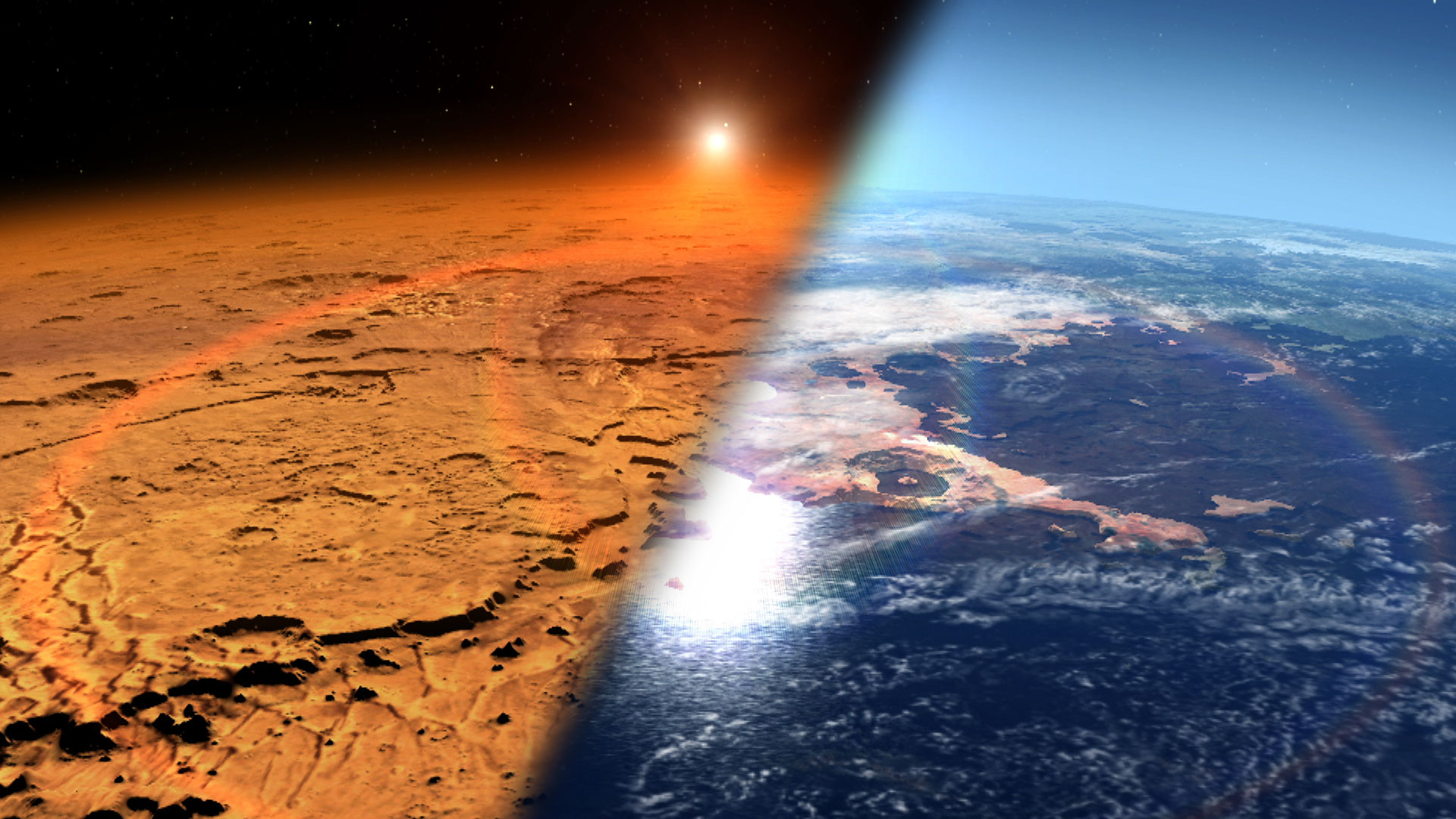
The results also suggest that such crater lakes were probably common on ancient Mars, before the atmosphere thinned and the climate became much colder. There may have been many such habitable environments on early Mars, but whether life actually did start at all is still an unanswered question.
As Grotzinger noted: “We have tended to think of Mars as being simple. We once thought of the Earth as being simple too. But the more you look into it, questions come up because you’re beginning to fathom the real complexity of what we see on Mars. This is a good time to go back to reevaluate all our assumptions. Something is missing somewhere.”
More information about the Curiosity rover mission is available here.
Want to keep up-to-date with all things space? Be sure to “Like” AmericaSpace on Facebook and follow us on Twitter: @AmericaSpace





How to explain the uplift this sequencie (rocks) without some vertical tectonics?
For a deeper read, the original article about this paper is at Caltech.edu: http://www.caltech.edu/news/wet-paleoclimate-mars-revealed-ancient-lakes-gale-crater-48249
The Caltech paper is hyperlinked in bold blue text in this article